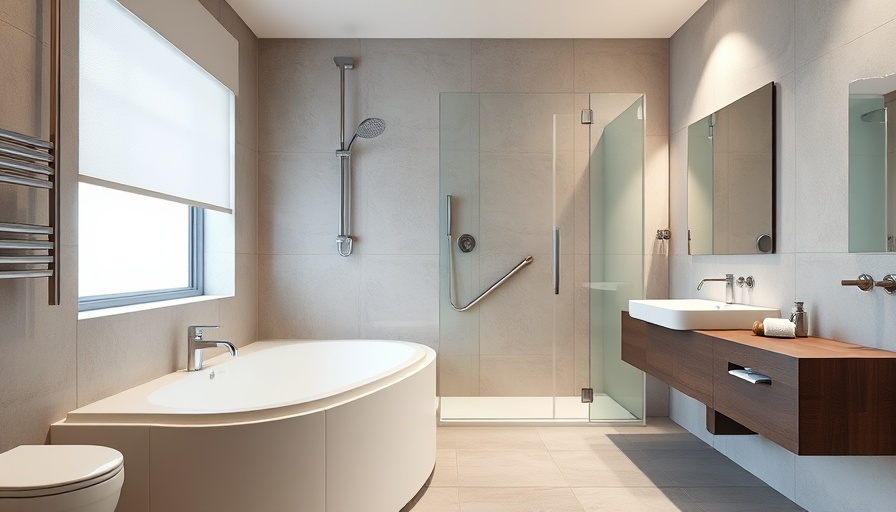
Choosing the Right Bathing Solution as You Age
As we navigate the golden years, creating an accessible and safe home environment becomes vital. Renovating bathrooms specifically offers unique opportunities to enhance safety and comfort, particularly as many consider walk-in tubs or showers. With the right choice, homeowners can enjoy a space that doesn't just cater to their technical needs but also contributes to their well-being and happiness.
Walk-In Tubs: A Comprehensive Look at Their Benefits
Walk-in tubs are more than just a bathing option; they are designed primarily with safety and comfort in mind. Unlike traditional tubs, these feature low thresholds that minimize the risks of falls—a significant concern for elderly users. Their built-in seating allows for comfortable bathing without the need to stand, which can be a relief for those with mobility challenges.
Another important benefit of walk-in tubs is the therapeutic advantage of soaking. Warm water offers soothing benefits, helping to alleviate muscle aches and stress. Many modern options are equipped with hydrotherapy features that can further enhance relaxation.
Moreover, walk-in tubs often include additional safety mechanisms, such as grab bars and non-slip surfaces, ensuring that users can enjoy their baths without anxiety about falls. For anyone focused on safety without sacrificing comfort, these tubs can be an invaluable addition.
Showers: The Flexible Alternative
On the other hand, traditional showers present a versatile alternative that is often more suited to compact spaces. They accommodate a range of styles from rain showers to multi-jet systems, allowing homeowners to customize their bathing experience according to their preference for convenience and luxury.
Showers typically operate more efficiently in terms of water usage compared to baths, making them a suitable option for environmentally conscious consumers. For families or busy professionals racing against time, the speed of a shower offers a practical solution.
Furthermore, a shower can usually enhance the aesthetic appeal of a bathroom, particularly when incorporating modern designs. Homeowners looking for space-efficient solutions without compromising on style might find showers to be a more fitting choice.
Cost Factors: A Deeper Dive into Investment
When comparing the installation costs of walk-in tubs and showers, it’s important to factor in not only the upfront expenses but also the long-term returns. Walk-in tubs generally have higher initial costs due to the specialized installation requirements and advanced safety features. For many, however, this investment aligns with their long-term safety priorities.
In contrast, showers often come at a lower initial investment, due to reduced installation complexities. Many homeowners observe that opting for a well-designed shower can enhance the overall resale value of a property. While evaluating these costs, it's crucial to balance short-term budgets with long-term benefits, particularly as accessibility becomes an integral part of home value.
Spatial Considerations: Making Room for Comfort
Space availability is a decisive factor in selecting between a walk-in tub and a shower. While larger bathrooms can accommodate both options comfortably, smaller spaces may necessitate a more thoughtful approach. Walk-in tubs typically require more square footage, which could be impractical for compact bathrooms.
However, creative planning might allow both options to coexist, turning a standard bathroom into a luxurious bathing oasis. Homeowners should assess their bathroom layout and personal preferences to determine the optimal set-up that fulfills their needs without sacrificing valuable space.
Aesthetic Appeal: Blending Functionality with Style
The visual aspect of bathrooms can significantly influence purchasing decisions. While both walk-in tubs and showers offer unique aesthetic opportunities, it's essential to choose features that harmonize with your home’s overall design.
Walk-in tubs come in various styles and finishes, allowing for customization that can complement existing décor, while multifunctional showers can introduce a modern flair that can elevate the bathroom's appearance. Selecting the right design helps create an inviting atmosphere, enhancing not just utility but also the emotional appeal of the space.
Making Your Choice: Factors to Reflect On
Ultimately, the choice between a walk-in tub and a shower should be informed by personal preferences, lifestyle needs, and long-term plans. Understanding the advantages and considerations of each option allows for an informed decision tailored to individual circumstances.
Homeowners should consider how each option meets their current and future needs, taking into account safety, aesthetic preferences, space constraints, and costs. By clearly defining their requirements, individuals can thoughtfully enhance their homes while prioritizing comfort and safety.
Conclusion: Making the Right Decision for Your Home
As you reflect on this significant decision, consider all aspects carefully. Whether you opt for a walk-in tub or a shower, the aim should be to foster a safe, supportive, and comfortable environment for yourself and loved ones.
Transforming a bathroom can greatly impact daily routines, enhancing both safety and well-being. Take the time to explore options and consult with professionals to ensure that your renovation aligns with your lifestyle and needs.
 Add Row
Add Row  Add
Add 




 Add Row
Add Row  Add
Add 

Write A Comment